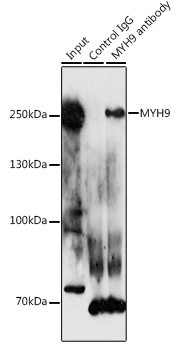MYH9 antibody [N1-2], N-term
GTX113236
ApplicationsImmunoFluorescence, ImmunoPrecipitation, Western Blot, ImmunoCytoChemistry, ImmunoHistoChemistry, ImmunoHistoChemistry Frozen, ImmunoHistoChemistry Paraffin
Product group Antibodies
TargetMYH9
Overview
- SupplierGeneTex
- Product NameMYH9 antibody [N1-2], N-term
- Delivery Days Customer9
- Application Supplier NoteWB: 1:500-1:3000. ICC/IF: 1:100-1:1000. IHC-P: 1:100-1:1000. IP: 1:100-1:500. *Optimal dilutions/concentrations should be determined by the researcher.Not tested in other applications.
- ApplicationsImmunoFluorescence, ImmunoPrecipitation, Western Blot, ImmunoCytoChemistry, ImmunoHistoChemistry, ImmunoHistoChemistry Frozen, ImmunoHistoChemistry Paraffin
- CertificationResearch Use Only
- ClonalityPolyclonal
- Concentration0.7 mg/ml
- ConjugateUnconjugated
- Gene ID4627
- Target nameMYH9
- Target descriptionmyosin heavy chain 9
- Target synonymsBDPLT6; cellular myosin heavy chain, type A; DFNA17; EPSTS; FTNS; MATINS; MHA; myosin, heavy chain 9, non-muscle; myosin-9; NMHC-II-A; NMMHCA; NMMHC-IIA; non-muscle myosin heavy chain 9; non-muscle myosin heavy chain A; non-muscle myosin heavy chain IIa; nonmuscle myosin heavy chain II-A; non-muscle myosin heavy polypeptide 9
- HostRabbit
- IsotypeIgG
- Protein IDP35579
- Protein NameMyosin-9
- Scientific DescriptionThis gene encodes a myosin IIA heavy chain that contains an IQ domain and a myosin head-like domain. The protein is involved in several important functions, including cytokinesis, cell motility and maintenance of cell shape. Defects in MYH9 are the cause of non-syndromic sensorineural deafness autosomal dominant type 17, Epstein syndrome, Alport syndrome with macrothrombocytopenia, Sebastian syndrome, Fechtner syndrome and macrothrombocytopenia with progressive sensorineural deafness. [provided by RefSeq]
- Storage Instruction-20°C or -80°C,2°C to 8°C
- UNSPSC12352203
References
- Akt1-associated actomyosin remodelling is required for nuclear lamina dispersal and nuclear shrinkage in epidermal terminal differentiation. Rogerson C et al., 2021 Jun, Cell Death DifferRead more
- Cisplatin-Mediated Upregulation of APE2 Binding to MYH9 Provokes Mitochondrial Fragmentation and Acute Kidney Injury. Hu Y et al., 2021 Feb 1, Cancer ResRead more
- Centrosome guides spatial activation of Rac to control cell polarization and directed cell migration. Cheng HW et al., 2019 Feb, Life Sci AllianceRead more
- Comparative proteomic analysis of mouse models of pathological and physiological cardiac hypertrophy, with selection of biomarkers of pathological hypertrophy by integrative Proteogenomics. Kwon HK et al., 2018 Jul 23, Biochim Biophys Acta Proteins ProteomRead more
- The E3 ligase Ubr3 regulates Usher syndrome and MYH9 disorder proteins in the auditory organs of Drosophila and mammals. Li T et al., 2016 Jun 22, ElifeRead more
- Arv1 promotes cell division by recruiting IQGAP1 and myosin to the cleavage furrow. Sundvold H et al., 2016, Cell CycleRead more
- Mass Spectrometry-Based Proteomics Identification of Enteropathogenic Escherichia coli Pedestal Constituents. Law HT et al., 2015 Jun 5, J Proteome ResRead more


